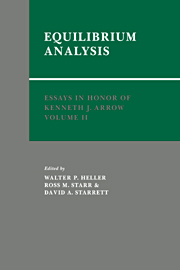Book contents
- Frontmatter
- Contents of Volumes I, II, III
- List of contributors
- Editors' preface
- Kenneth J. Arrow
- Contents
- PART I GENERAL EQUILIBRIUM
- PART II MICROFOUNDATIONS OF MACROECONOMICS
- 7 Price flexibility, inventory behavior, and production responses
- 8 On asymmetric information, unemployment, and inflexible wages
- 9 Asymmetric adjustment costs and sectoral shifts
- 10 Implicit contracts and risk aversion
- 11 An exercise in non-Walrasian analysis
- 12 Monopolistic competition and the multiplier
- Author index
12 - Monopolistic competition and the multiplier
Published online by Cambridge University Press: 25 October 2011
- Frontmatter
- Contents of Volumes I, II, III
- List of contributors
- Editors' preface
- Kenneth J. Arrow
- Contents
- PART I GENERAL EQUILIBRIUM
- PART II MICROFOUNDATIONS OF MACROECONOMICS
- 7 Price flexibility, inventory behavior, and production responses
- 8 On asymmetric information, unemployment, and inflexible wages
- 9 Asymmetric adjustment costs and sectoral shifts
- 10 Implicit contracts and risk aversion
- 11 An exercise in non-Walrasian analysis
- 12 Monopolistic competition and the multiplier
- Author index
Summary
Motivation
The trained instinct of the modern rigorous economist is to reach first for the Walrasian model. Maybe it is – like the Army, Navy, Air Force, and Marines – a great place to start. Most of us, however, live with the ineradicable feeling that large and important areas of economic life cannot be described in that way. One of the admirable things about Kenneth Arrow's work is that even while making major contributions to the perfection of the Walrasian model, he has never blinked its deficiencies and has sought for alternatives more suited to the facts of life in modern industrial economies.
What follows is a very preliminary step in that direction. This particular story leaves very large gaps of its own. I will leave until the end my own appreciation of what they are. Some of them are patched up in a more complete and therefore more complicated version of the model that will appear as my 1985 Mitsui Lectures at the University of Birmingham.
My immediate starting point is the article by Martin Weitzman (1982). My goal is to marry it to the simplest model of effective demand. In his article, Weitzman argued that the natural habitat of any theory of persistent involuntary unemployment is an economy with nontrivial increasing returns to scale. The main reason he gives is that otherwise it is impossible to explain why bits of unemployed resources do not form tiny scale replicas of the going economy and thus employ themselves.
- Type
- Chapter
- Information
- Essays in Honor of Kenneth J. Arrow , pp. 301 - 316Publisher: Cambridge University PressPrint publication year: 1986
- 1
- Cited by



